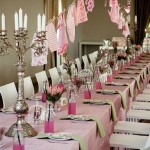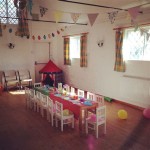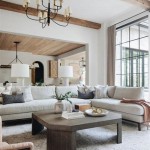Harmonizing Kitchen and Living Room Decor: A Comprehensive Guide
The open-plan living space, encompassing the kitchen and living room, has become a ubiquitous feature of modern homes. This design offers a spacious and sociable environment, but it also presents unique decorating challenges. Achieving a cohesive and aesthetically pleasing flow between these two distinct areas requires careful consideration of various design principles and practical elements.
Successfully integrating kitchen and living room decor hinges on establishing a visual connection while acknowledging the differing functions of each space. The goal is to create a unified ambiance that is both stylish and functional, conducive to both cooking and relaxation. This article explores key considerations and strategies for achieving harmonious kitchen and living room decor.
Establishing a Consistent Color Palette
One of the most effective methods for unifying a kitchen and living room is through a well-chosen color palette. The color scheme should be consistent across both areas, but subtle variations can be introduced to define each space's unique character. A common approach is to select a neutral base color, such as gray, beige, or white, and then incorporate accent colors in both the kitchen and living room. These accent colors can be introduced through furniture, accessories, and wall decor.
The choice of colors can significantly influence the overall mood of the space. Warm colors, such as reds, oranges, and yellows, can create a cozy and inviting atmosphere, while cool colors, such as blues, greens, and purples, can evoke a sense of calm and serenity. When selecting colors, it is essential to consider the natural light available in the space. Darker colors can make a room feel smaller and more enclosed, while lighter colors can brighten and expand the perceived size of the space. Consider the colors of the cabinetry, countertops, and backsplash in the kitchen and ensure they complement the colors chosen for the living room walls, furniture, and accessories.
Consider using a monochromatic color scheme, where variations of a single color are used throughout both rooms. This approach creates a sophisticated and harmonious look. Alternatively, a complementary color scheme, using colors that are opposite each other on the color wheel, can create a more vibrant and dynamic feel. The 60-30-10 rule can be helpful, designating 60% of the space to the dominant color, 30% to a secondary color, and 10% to an accent color. This helps to create a balanced and visually appealing space.
Maintaining a Unified Design Style
The design style employed in both the kitchen and living room should be consistent to create a sense of unity. Whether the preferred style is modern, traditional, rustic, or eclectic, it is important to carry the key elements of that style throughout both spaces. This does not mean that the decor must be identical, but rather that it should share a common aesthetic.
If the kitchen features sleek, minimalist cabinetry and stainless steel appliances, the living room should reflect a similar modern sensibility, perhaps with clean-lined furniture and minimalist accessories. Conversely, if the kitchen boasts a more traditional design with ornate cabinetry and warm wood tones, the living room should complement this aesthetic with comfortable, upholstered furniture and classic decor elements. The use of similar materials, such as wood, metal, or glass, can also help to create a cohesive look.
Pay attention to the architectural details of the space. If the kitchen has exposed brick or wooden beams, consider incorporating similar elements into the living room decor. The style of the furniture, lighting fixtures, and artwork should also be consistent with the overall design style. For example, a farmhouse kitchen might be complemented by a living room with rustic wooden furniture, vintage accessories, and natural textiles. A modern kitchen might be paired with a living room featuring sleek, minimalist furniture, geometric patterns, and industrial-style lighting.
Avoid mixing drastically different styles, as this can create a disjointed and jarring effect. While it is possible to incorporate elements from different styles, it is important to do so thoughtfully and purposefully, ensuring that the overall aesthetic remains cohesive. Consider using a common thread, such as a specific color, pattern, or material, to tie together different design elements.
Creating Visual Transitions and Defining Zones
While consistency is important, it is also crucial to subtly define the boundaries between the kitchen and living room. This can be achieved through various visual cues, such as changes in flooring, area rugs, furniture placement, and lighting. These elements help to delineate the different functions of each space without creating a hard separation.
A change in flooring can effectively delineate the kitchen from the living room. For instance, the kitchen might feature tile or hardwood flooring, while the living room has carpet or a larger area rug placed to define the seating area. Area rugs can also serve as visual anchors, defining specific zones within the living room, such as a conversation area or a reading nook. Furniture arrangement can also play a key role in defining these spaces. A kitchen island, a breakfast bar, or a strategically placed sofa can serve as a natural divider between the two areas.
Lighting is also a powerful tool for defining zones. The kitchen may benefit from bright, task lighting to illuminate work surfaces, while the living room can be illuminated with softer, more ambient lighting to create a relaxing atmosphere. Pendant lights over the kitchen island can create a focal point and visually separate the kitchen from the living room. Consider using dimmers to adjust the lighting levels in both spaces, creating different moods for different times of day.
Incorporate decorative elements that subtly reinforce the separation. For example, a gallery wall in the living room can draw the eye away from the kitchen area, while a plant display in the kitchen can create a natural barrier. The use of window treatments, such as curtains or blinds, can also help to define the spaces and control the amount of natural light entering each area.
Integrating Functionality and Aesthetics
Effective kitchen and living room decor should not only be aesthetically pleasing but also highly functional. This requires careful consideration of storage solutions, furniture selection, and traffic flow. The goal is to create a space that is both beautiful and practical, catering to the needs of everyday living.
In the kitchen, maximize storage space by utilizing vertical storage solutions, such as tall cabinets and shelving units. Consider incorporating hidden storage features, such as pull-out drawers and appliance garages, to keep clutter at bay. In the living room, choose furniture that is both comfortable and functional. A sofa with built-in storage or a coffee table with drawers can provide extra storage space for blankets, pillows, and other items. Ensure that there is ample seating for family and guests, and arrange the furniture to encourage conversation and interaction.
Pay attention to the traffic flow between the kitchen and the living room. Ensure that there is a clear and unobstructed path between the two areas. Avoid placing furniture or accessories that could impede movement. Consider the placement of appliances in the kitchen to minimize congestion and create a more efficient workspace. The layout of the kitchen and living room should be designed to accommodate the needs of the occupants, allowing for comfortable and easy movement between the two spaces.
Incorporate elements that blend functionality and aesthetics. For example, a decorative fruit bowl in the kitchen can serve as both a functional storage solution and a decorative accent. A stylish bookshelf in the living room can provide storage for books and display decorative items. Choose accessories that are both beautiful and practical, such as decorative baskets, serving trays, and throw blankets.
Selecting Complementary Furniture and Accessories
The furniture and accessories chosen for the kitchen and living room should complement each other in terms of style, color, and materials. This does not mean that the furniture must be identical, but rather that it should share a common aesthetic that ties the two spaces together.
When selecting furniture for the living room, consider the style of the kitchen cabinetry and countertops. If the kitchen features modern cabinetry with clean lines, choose furniture that reflects a similar aesthetic. Conversely, if the kitchen boasts a more traditional design, select furniture with classic lines and comfortable upholstery. Consider the color palette of the kitchen when choosing furniture for the living room. Choose colors that complement or contrast with the kitchen colors, creating a visually appealing and harmonious space.
Accessories can also play a key role in unifying the kitchen and living room decor. Choose accessories that reflect the overall design style and color palette of the space. Consider using similar materials, such as wood, metal, or glass, in both the kitchen and living room. For example, a wooden cutting board in the kitchen can be echoed by a wooden coffee table in the living room. Metal accents in the kitchen, such as stainless steel appliances, can be complemented by metal decorative objects in the living room.
Incorporate personal touches that reflect the occupants' individual style and preferences. Artwork, photographs, and decorative objects can add personality and character to the space. Choose items that resonate with the occupants and create a sense of warmth and comfort. Avoid cluttering the space with too many accessories, as this can create a chaotic and overwhelming effect. Instead, focus on selecting a few key pieces that make a statement and enhance the overall design.
The Importance of Lighting
Lighting is a crucial element in achieving harmonious kitchen and living room decor. Proper lighting can enhance the functionality of each space, create a desired ambiance, and visually connect or separate the areas as needed. A layered lighting approach, combining ambient, task, and accent lighting, is recommended for optimal results.
In the kitchen, task lighting is essential for illuminating countertops, sinks, and cooking areas. Under-cabinet lighting is an effective way to provide focused light for food preparation. Pendant lights over the kitchen island can serve as both task lighting and a decorative element. In the living room, ambient lighting can create a warm and inviting atmosphere. Recessed lighting, chandeliers, or floor lamps can provide general illumination. Table lamps and sconces can add accent lighting, highlighting artwork or architectural features.
Consider the color temperature of the light bulbs. Warm white light creates a cozy and inviting atmosphere, while cool white light provides a brighter and more energizing effect. Choose light bulbs with a color temperature that complements the overall design style and color palette of the space. Dimmers can be used to adjust the lighting levels in both the kitchen and living room, creating different moods for different times of day. This is particularly useful in an open-plan space where the ambiance may need to shift throughout the day.
Strategically placed lighting can also help to define the boundaries between the kitchen and living room. Pendant lights over the kitchen island can visually separate the kitchen from the living room. A floor lamp in the corner of the living room can create a focal point and draw the eye away from the kitchen area. The use of different types of lighting fixtures in each space can also help to differentiate the two areas.

Bring Kitchen Living Room Design Ideas To Life

17 Open Concept Kitchen Living Room Design Ideas Style Motivation

How To Design An Open Plan Kitchen And Living Room

Open Concept Kitchen And Living Room 55 Designs Ideas Interiorzine

19 Incredible Open Plan Kitchen Living Room Ideas A House In The Hills

15 Open Concept Kitchens And Living Spaces With Flow

Building An Open Concept Kitchen Living Room In 2025 Foyr
:max_bytes(150000):strip_icc()/MichelleBoudreau8926Revision-4318x2880x368x0x3840x2880x1664884559-2756c4d88fc948f29b52ac17580b1912.jpg?strip=all)
28 Open Kitchen Living Room Ideas To Create A Cohesive Space

15 Kitchen Living Room Combo Ideas Perfect For Smaller Spaces Coco Lapine Designcoco Design

Brown White Modern Kitchen Design Ideas Decorating Living Room Kansas City By User Houzz
Related Posts







